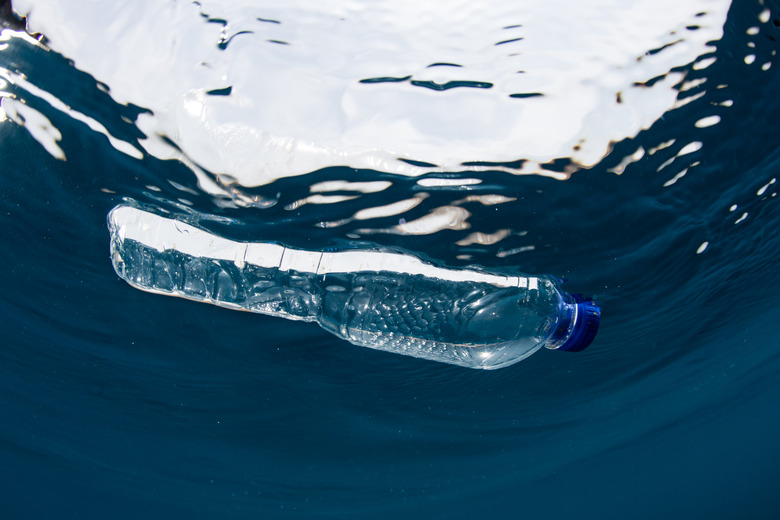What Is The Carbon Footprint Of A Plastic Bottle?
There's more to a plastic water bottle than meets the eye. Knowing its environmental impact just might make a person think twice about grabbing bottled water from the grocery store shelf. The Pacific Institute, a nonprofit research organization, estimates that the energy used in the production and use of plastic bottles is equivalent to filling the bottles one-quarter full with oil. (Oil affects global warming by producing high quantities of greenhouse gases when it's burned.) Here's a deeper dive into the carbon footprint of a plastic water bottle.
TL;DR (Too Long; Didn't Read)
The manufacture of one pound of PET (polyethylene terephthalate) plastic can produce up to three pounds of carbon dioxide. Processing plastic resins and transporting plastic bottles contribute to a bottle's carbon footprint in a major way. Estimates show that one 500-milliliter (0.53 quarts) plastic bottle of water has a total carbon footprint equal to 82.8 grams (about 3 ounces) of carbon dioxide.
Transportation of Raw Materials
Transportation of Raw Materials
Plastic bottles are made of resins derived from oil or refined petroleum and natural gas. The petroleum and gas are sometimes transported long distances to plastic manufacturers, using fossil fuels and producing emissions of greenhouse gases. The size of the carbon footprint depends on the mode of transportation and the distance raw materials have to travel. For example, truck transportation causes more carbon dioxide emissions than rail shipping. When long distances are involved, **transportation energy expenditures can represent as much as 29 percent of a plastic bottle's carbon footprint.**
Making Plastic Resins
Making Plastic Resins
The manufacture of plastic resins accounts for the highest percentage of a plastic bottle's carbon footprint. During processing, hydrocarbons in petroleum and natural gas are heated to extremely high temperatures to break down large hydrocarbon molecules into smaller ones. The small hydrocarbons are then combined in different ways to make various types of plastic. PET resin, resembling grains of rice, is the source material for plastic PET bottles. **The energy to produce PET resin represents about 30 percent of the total carbon footprint of a 500-milliliter plastic bottle.**
Plastic Bottle Production
Plastic Bottle Production
Energy is needed to convert plastic resin into plastic bottles. Plastic resin is melted and injected into a mold, and then heated and formed into bottles. **This final process represents about eight percent of a plastic bottle's carbon footprint.**
Other Variables
Other Variables
Cleaning, filling, storing and packaging plastic bottles also uses energy. Waste generation, including carting plastic bottles to landfills, adds to a bottle's carbon footprint. **The total of these processes can represent 33 percent of a plastic bottle's carbon footprint.**
Carbon Footprint Calculators
Carbon Footprint Calculators
Carbon footprint calculators for individuals, children and businesses are available online; some are free. Calculators for individuals usually address general lifestyle activities and their estimated greenhouse gas emissions. Results from different calculators may vary, but they can help consumers figure out where in their daily habits they can conserve.
Production Alternatives
Production Alternatives
Given that production of plastic resin is usually the major contributor to the carbon footprint of a plastic bottle, recycling can reduce carbon dioxide and other greenhouse gasses by an estimated 30 to 70 percent. Other environmentally friendly alternatives include using less plastic for bottles, making a lighter bottle, and reducing transportation distances and other energy-intensive processes. Research into other types of plastics and materials not derived from fossil fuels could significantly reduce plastic bottles' carbon footprint.
References
Cite This Article
MLA
Blue, Marie-Luise. "What Is The Carbon Footprint Of A Plastic Bottle?" sciencing.com, https://www.sciencing.com/carbon-footprint-plastic-bottle-12307187/. 11 June 2018.
APA
Blue, Marie-Luise. (2018, June 11). What Is The Carbon Footprint Of A Plastic Bottle?. sciencing.com. Retrieved from https://www.sciencing.com/carbon-footprint-plastic-bottle-12307187/
Chicago
Blue, Marie-Luise. What Is The Carbon Footprint Of A Plastic Bottle? last modified August 30, 2022. https://www.sciencing.com/carbon-footprint-plastic-bottle-12307187/
